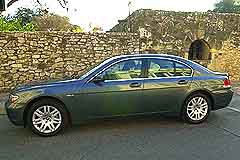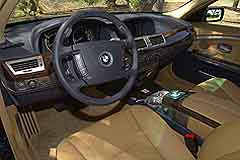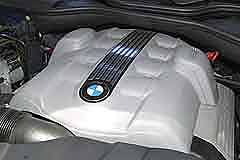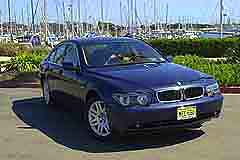
Base MSRP Range: $68,500 to $115,800
Base Invoice Range: $62,500 to $106,000
Price Quote
MSRP As Tested: $68,500
Versions: 745i, 745Li, 760Li
Vehicle Category: Full-Size Luxury Sedan
Engine Location: Front Engine
Drive Wheels: Rear-Wheel Drive Rear-Wheel Drive
Engine As Tested: 745i and 745Li have a4.4-liter, Dual Overhead Cam, V-8 cylinder, 325-horsepower at 6,100 rpm and 330 lb-ft torque at 3,600 rpm. The 760Li has a 6.0-liter, Dual Overhead Cam, V-12 wotj 438-horsepower at 6,000 rpm and 444 lb-ft. torque at 3,950 rpm.
Transmission As Tested: 6-Speed Automatic
Fuel Economy (city/hwy): 745i and 745Li - 18/26. 760Li - 15/22.
Standard Safety Features: Driver and front passenger, front and side airbags, front knee airbags, front and rear head-protection airbags, 4-wheel disc brakes, "> Antilock Braking System, Traction Control, In-Trunk Emergency Trunk Release, Daytime Running Lights, Brake Assist, Antiskid System, Remote Keyless Entry.
Competition: Audi A8, Audi S8, Infiniti Q45, Jaguar XJ-Series, Lexus LS 430, Mercedes-Benz S-Class, Volvo S80.
Forty years ago this area was only known for hearty German inspired BBQ, and BMWs were funky little German cars known for their spicy handling. Now the rusty pickups still abound in front of the still unpainted rustic ice houses (South Texan for beer emporium) but lots of the houses have some sort of German car parked in the drive next to the obligatory pick-um-up.
The transition from backwater to refined lifestyle has been slow and measured; for both the locale and the manufacturer have allowed the change to come naturally . . . they have not forced it. While other car companies have suddenly decided and crowed that their products were now luxury cars, BMW has let the customers tell them that, and with this new 7 Series, they finally are willing to agree with them.
BMW has had a long tradition. While most other car companies have continually reinvented themselves over the years, BMW has been dedicated to sporty handling and performance, even as they branched into the luxury and utility areas. The new E65, as the 7-series flagship is called internally, will set the direction for the future of BMW luxury and technology.
As expected, the next 7-Series is completely new but is not a styling revolution, with the traditional arch-shaped roof and generous glazing, despite the ruckus the rear treatment has received from the German press. The front and rear are more rounded, massive, but not fat with a curve swooping down from the character line to ground the car at both ends. It manages to appear both elegant and sporty, and the 7-series comes across well as a driver's car. It has the traditional lidded (and very effective!) Bi-Xenon headlamps, eyebrow neon turn signals and new distinctive diagonal rear lights. And it is that back end that has created the controversy.
Designer Chris Bangle points out that shorter, more lifestyle efficient cars tend to have high rear ends for aerodynamic and trunk space benefits. He could have wedged the design as so many others have, or penned other tail light treatments like Volvo's S80, but by leaving a lower character line he enlarged the rear window glass, and provided a wide trunk opening. You'll have to decide whether it is different or unsettling.
One of the problems with large luxury cars is that they are expected to have a large number of sophisticated features to pamper (mollycoddle?) their owners. The upshot of sophisticated audio systems (better than most home stereos), global communication links, GPS navigation systems, and climate control units (that rival those found in computer rooms) is that all of these require oodles of interfaces with the driver. Buttons proliferate -- often small, hidden and nigh on indecipherable, emblazoned with hieroglyphics that can only be translated with a Rosetta stone in the guise of an Owner's Manual (and who reads those anyway.)
Buyers expect these features. After all how else do you distinguish a $70,000+ automobile from an upstart, affordable Hyundai XG350? BMW presents a minimalist cockpit, copying the interior themes shown in the Z9, avoiding the complexity of so many luxury cars. One competitor has 79 switches for the driver - and more for each other occupant - and that does not count levers and knobs! (I didn't have that many in the jet fighter I flew in the 60s, and it had bombs and missiles to play with!)
Although the two traditional round gauges remain, the previous clumsy center console is replaced with an eight function central display, accessible to and controllable by both the driver and the front passenger with the computer inspired iDRIVE knob, designed with an emphasis on intuitive operation.
BMW seems to have found a good answer to driver information overload. Using an oversized control (think of the wash cycle knob on a washing machine) front seat occupants can control all of the major systems of the vehicle; climate, communication, entertainment, and navigation, plus four other secondary features. The knob rotates, shifts in all direction and depresses to select features and displays settings in a hooded center screen that is quite visible in most lighting situations. The knob also has 'feedback', so if you attempt to do something that is not permissible the knob resists your motions. And that 'feedback' changes from function to function.
Their standard navigation system is not only easy to use with the iDRIVE, but is perhaps as good to use as any in my experience and the screen layout is excellent. Even better, the major directions also appear in the center of the tachometer, keeping the driver's eyes from having to wander. And those gauges have been redesigned with soft red/orange illumination highlights rather than the long-established but garish red-only display.
The iDRIVE is just the start of BMW's different way of looking at traditional controls. You're confronted with novel methods of starting the engine and selecting gears. First, there is no key that must be twisted in an ignition. Rather, the fob is inserted in a slot on the dash, then with your foot on the brake, the 'Start/Stop' button is depressed to start the engine. The gearshift lever, (one of four levers on the steering column) is moved back and up to engage reverse - drive is forward and down. Park is engaged by pushing inward on the end of the shift lever. To select the parking brake, just push a button on the dash to engage, and push again to release it. You get the feel that BMW challenged all systems engineers to take a fresh look a how their controls should be operated, not just how they had been done in the past, then gave them the freedom to execute their ideas. The 7 cockpit may take a little getting used to, but they are all logical and easy to operate.
The 7 series has a very useful voice command. A button on the steering hub is pressed to engage Voice Activation. It will dial your phone, tune your radio or skip that particularly bad track on a CD. The voice recognition was put to the test with two people speaking in unison (almost). Quite impressively, it picked out the radio frequency requested without hesitation. In the future a satellite radio and internet connection will be natural evolutions.

The entire interior is clean and uncluttered; not only stylish but comfortable. The seats have up to 20 way adjustable controls, once again in an uncommon place on the side of the console, and they operate a bit differently, but are easy to get used to. A welcome option is the adjustable rear seat, and even in the present short wheel base version, there is plenty of leg room for tall folks. A curious thing that defeated BMW tech was an automated headrest height system that kept trying to match the groceries that were not well secured in the back seat.
Electronics play an important part. BMW promises headlights that follow the road - ALC (adaptive light control); will keep the car in its lane with HC (heading control); and keep its distance from the vehicle ahead with ACC (active cruise control). Also new is the integrated chassis management (ICM) that contains a further refined stability program, active roll compensation and a force control system that enhances the comfort as well as the driving security. The electro-hydraulic brake system operates through a computer (brake by wire). This will enable constant pedal forces, shorter stopping distances as well as an automatic parking brake with rollback prevention on hills and at traffic lights.
We will see 42-volt electrical systems on BMW 7s in the very near future for more efficiency, weight savings and to lead us into advanced hybrid fuel cell assist systems. If we isolate just one rear door for a count, we'll see that we have a built in audio speaker(s) - an electrical motor -, a motor to close the door (if not shut all the way), the power window motor, power lock solenoid, and a set of power screen motors. Combine that with the motors found in seats, doors, the trunk, the dash and you'll realize that the alternator on this car is a mini power station. There is no outside key entry and the trunk opens and closes with electric motors. Keep the remote control battery in good shape!
The optional Logic 7 audio system is a real treat. Given the quiet nature of this car, listening to classical music is a joy. The highlight of the Logic 7 system is its ability to accurately portray the soundstage. Instruments and voices are isolated in space, as opposed to being jumbled together with other sounds. Thanks to the utilization of a digital signal processor the surround sound systems from the Harman International group (Harman/Kardon) creates a 360 degree sound field which can reveal the very soul of the music being played.
The aluminum chassis is an evolution of the 5-Series with electronically adjusted air suspension and computer controlled hydraulic cylinders for reduction of pitch and roll. Variable assist, variable ration steering is seamless, and the 7 is responsive without being harsh. All done without air suspension or computer controlled active suspension - a feat competitors deems impossible. For maximum performance, 18 and 19 inch wheels are available and 20 inch wheels will be an option.

And the engine is the usual paragon we've grown to expect, now 325 hp, equal to the previous V12 engine. Valvetronic eliminates the vagrancies of previous throttle controllers by varying the intake valve lift to match the go pedal demands, and variable valve timing on all four cams combines with a fully variable intake manifold for unparalleled power and efficiency coexistence.
While the new 7-Series will only be available with an automatic transmission, a six-speed ZF with Steptronic selectable shifting is exceptional, smooth and always seems to know where the driver wants it to be. In Europe most will get the six-cylinder 730i and two diesel variants. The US will get the larger of two V8 models and soon an enlarged 12-cylinder 750i that climbs from 5.4- to 6.0-litres and rises to 400 hp, equipped with new heads with four fully variable valves and direct ignition.
Soon there will be a long-wheelbase version, and by 2004 you will be able to buy a Rolls-Royce derived from the same components set. There was to be an absolute luxury class as 9-Series that changed with the new management team and the acquisition of the British nameplate. An M model will come to these shores for the first time.
Karl Ludvigsen, an auto analyst in London is quoted in Time, contends that a carmaker need not be huge to survive. Rather, he says, "you've got to be big in the segments in which you compete, and you've got to be competitive in those segments globally." |
Daimler coupled with Chrysler, Renault bought Nissan, VW has acquired just about every small company in Europe, GM gobbled up just about every Asian company that had not already linked with Toyota, and Ford scooped up Volvo, Jaguar and anything that smacked of British heritage.
Everybody mused that it was just a matter of time before the biggies gobbled up BMW and Honda, and maybe even Porsche. Yet here we are in 2002, and among the most successful players in the auto industry are . . . BMW, Honda and Porsche. Suppliers to these increasingly sophisticated companies are taking on an ever-larger share of development costs.
Besides, BMW is going to get a shot at the suppliers' best technology because suppliers want to be associated with them. Porsche even has an engineering-services division that supplies other automakers with high-end equipment. First-quarter sales set records, especially in North America, where BMW is selling more cars than Mercedes.
DaimlerChrysler chairman Schrempp may be proved right over the next decade, but what's decisive now is not so much size as (surprise!) sound management. Which car company is nimble enough to hop in and out of new market niches and still provide high-quality, sexy cars that people aspire to own?

Mike Flynn, an auto expert at the University of Michigan, observes that new technology is only one of the elements - including styling and reliability - that make a car attractive. "Companies like BMW and Honda," he says, "offer products that keep them successful." So does Porsche, where sales are up 16% so far this year. It produces a mere 48,815 cars a year - vs. 1 million for Mercedes and 1.8 million for all of DaimlerChrysler - but at an enviable 11.9% profit margin.
What's special about BMW is its management depth and persistence. Two years ago, the company floundered when its attempt to get big - the 1994 takeover of Britain's Rover - went awry. A combination of a bad choice for the wrong reasons, and bad management decisions resulted in the shedding of Land Rover at a good price to Ford, and a gift of Rover to anyone who would take it. The may come out smelling rosy with by keeping the appealing Mini project.
Pros: Magnficent exterior styling. The performance and handling of a true luxury sedan. Fabulous technology and loads of it. Beautiful interior appointments.
Cons: Expensive. Weird interior design cues.
Ratings (1-10)
- Style: 9
- Performance: 9
- Price: 8
- Handling: 9
- Ride: 10
- Comfort: 9
- Quality: 10
- Overall: 9.1
MORE DATA
Where Built: Germany
Major Options: break-resistent glass, active cruise control, active head restraints, automatic trucnk open and close, heated and massagine seats, heated steering wheel, larger tires, obstacle detection, rear climate controls, rear power sunshade, self-leveling rear suspension, sport suspension, tire pressure monitor, upgraded stereo.
Seating: 5
Number of Rows: 2
Crash Test Ratings:
- NHTSA Frontal Impact/Driver Crash Test Rating: Not Yet Tested
- NHTSA Frontal Impact/Passenger Crash Test Rating: Not Yet Tested
- NHTSA Side Impact/Front Seat Crash Test Rating: Not Yet Tested
- NHTSA Side Impact/Rear Seat Crash Test Rating: Not Yet Tested
- NHTSA Rollover Resistance Rating: Not Yet Tested
- IIHS Frontal Offset Crash Test: Not Yet Tested
Length in Inches: 745 - 198.0. 760 - 203.0.
Warranties: 4 years/50,000 miles bumper-to-bumper, 6 years/unlimited miles corrosion, 4 years/50,000 miles free Roadside Assistance, 3 years/36,000 miles Free Scheduled Maintenance.
Weight in Pounds: 745 - 4,376. 760 - 4,464.
Towing Capacity in Pounds: Not Applicable
Gas Tank Capacity in Gallons: 23.3
Destination Charge: $695




